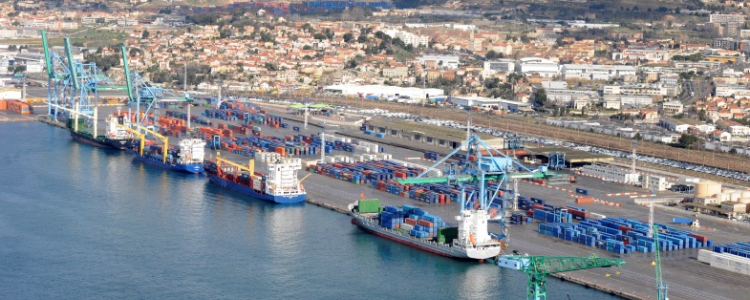
Marseille Fos Port
Marseille is on the Mediterranean coast in the south of France, in the region of Provence-Alpes-Côte d’Azur. On a national scale, Marseille is the 2nd largest city in terms of population after Paris. Therefore, Marseille benefits from all the infrastructures present in a capital city. A particular advantage is Marseille Fos port, which is one of the Major Seaports of France.
Strategic location on the Mediterranean coast
Considered as a major southern European port, Marseille Fos port looks out over the Mediterranean Ocean. The access that it provides is important because of its location in the south of France, thus offering wide variety of connections:
- Italy – connections with the island of Sardinia
- Africa – connections between Europe and northern and western Africa
- Asia – via the Suez Canal, Marseille Fos port allows you to get to the Middle East
- Island of Corsica
Marseille Fos port is made up of two areas. The East area has an area of 400 hectares. At the heart of the city, this urban port zone is known as the local port for goods and passengers. The West area is in the industrial area of Fos-sur-Mer, which has 10,000 hectares including 3000 hectares of natural space. This part of the port is dedicated to international commerce and to the logistics and industrial sectors.
A multimodal port: river, rail, road and pipeline
The Marseille Fos port offers 4 ways of circulating goods to cover the needs of each business sector.
Road network
The terminals of the port, which make up at least 80% of all transport, are connected to the French road network which is connected to Europe.
Rail network
Although rail transport makes up 15% of goods transportation, one of the port’s aims is to triple the volume transported by rail in 4 years’ time.
Some important figures:
- 7 million tonnes of goods
- 150 trains per week
- 22 destinations in France and 9 in Europe
- Combined transport thanks to 5 operators: Naviland Cargo, Greenmodal, T3M, Ferovergne and Delta rail
- Investment of 20 million euros since 2008 to improve railway infrastructures
River network
With 6% of good traffic, one of the unique aspects of this port is the river connection between the Mediterranean and the Rhône-Saône axis. This has been possible thanks to Medlink Ports, which brings together seaports and internal ports from this axis with the support of river and rail infrastructures.
Important information:
- 3 million tonnes of goods
- 5 regular services per week to Valencia, Lyon and Macon
- 500km of network on a large scale
Transport by pipeline
This system allows for the movement of bulk liquids in a secure way, notably crude or refined hydrocarbons. This modality is closely linked to the river network, as this part aims to triple the volume transported by pipeline.
Goods and traffic at Marseille Fos port
All types of industrial goods are welcome at this port. The sectors which are already established there benefit from different services and infrastructures at the Marseille Fos port.
Conventional goods
- Regular shipping lines for heavy parcels to 7 Mediterranean countries
- 2.5 million tonnes of traffic
- 1 ro-ro ramp with a capacity of 800 tonnes
Containers and reefers
- 1st port in France in terms of transport of containers
- Extension of 2.6km, the longest dock in Europe
- Port is located at the crossroad of international shipping routes
- Journeys to 500 international ports
- 25 ship stopovers per day
- Capacity of 3 million m2 of storage
Industry
- Commitment to industry in ecological transition
- The industrial-port zone of Fos-sur-Mer is one of the largest in Europe
- Strong presence of large companies in steel, energy and petrochemicals: ArcelorMittal, Ascométal, KEM One
- 2 LNG terminals and 2 refineries
- 2 wind farms: 4 turbines at Fos Caban Sud and 25 wind turbines at Port-Saint-Louis-du-Rhône
- 300,000 tonnes of traffic per year
Logistics
- Part of the logistics backbone between Lille, Paris, Lyon and Marseille
- More than 3 million square metres of logistics warehouse space in a 30km radius
- Two logistics zones dedicated to bonded storage and distribution in Europe: Fos Ditriport and La Feuillane
Digital
"French Smart Port in Med” approach with the following objectives
- Improvement of the port, logistics, and industrial economy and ecosystem of the port
- New job offers
- Strengthening of links between the port and the city of Marseille
- Revaluation of the port in the Mediterranean Sea
Naval repairs
- 1st naval repairs hub in the Mediterranean specialising in large yachts
- 3rd largest ship repair centre in the world
- 119 ships treated on dry land
- 149 ships treated afloat
Rovers and cars
- 3 rover terminals and 3 car terminals
- Port connected to France’s road network with direct access to Europe
- 4.5 million tonnes of cargo handled
- 207,000 new vehicles
- 210,000 trailers
Passengers
- 1st cruise port in France and 4th in the Mediterranean
- 3 million passengers per year
- 1.8 million cruise passengers
- 510 cruise stopovers in 2019
Bulk liquids and solids
- 1st petrochemical complex in France and 4th in Europe
- 1st European hub for liquefied petroleum gas (LPG)
- 2 dedicated terminals for liquefied natural gas (LNG)
- 3 terminals dedicated in chemical and petrochemicals
- River connection for industry and the food processing industry
Liquid bulk traffic
- 22 million tonnes per year of crude oil
- 2 million tonnes per year of LPG
- 11 million tonnes per year of refined products
- 6 million tonnes per year of LNG
Dry bulk traffic
- 12.7 million tonnes of dry bulk cargo
- 8.5 million tonnes of steel bulk
- 591,000 tonnes of bulk foodstuffs

